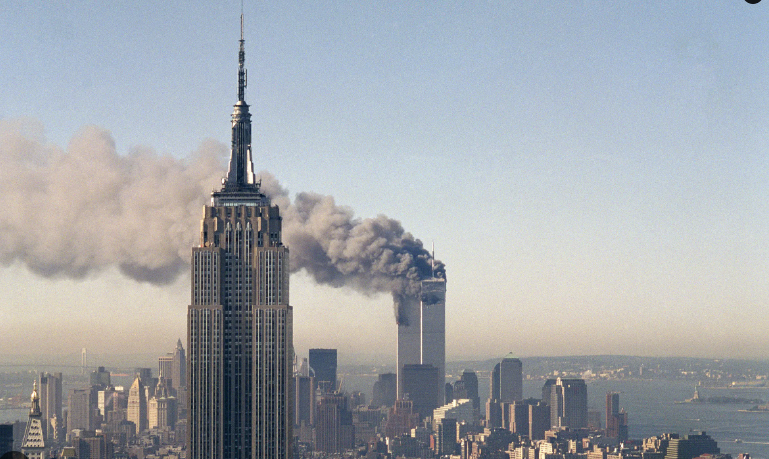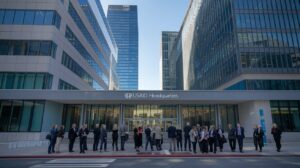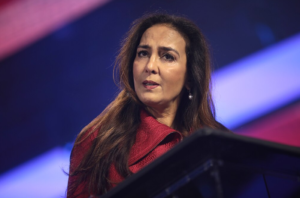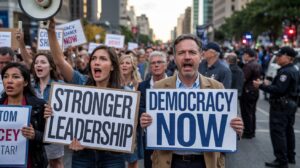
The September 9/11 Attacks: A Deep Dive into the Tragedy and Its Implications
1. The September 9/11 Attacks: A Timeline
- Early Morning Hijackings:
- On the morning of September 11, 2001, a series of unprecedented and terrifying events unfolded that would forever change the course of history. The September 11 attacks began with the early morning hijackings of four commercial airplanes.
- American Airlines Flight 11: At 7:59 AM, this Boeing 767 took off from Boston’s Logan International Airport en route to Los Angeles. Just a short time into the flight, terrorists hijacked the plane. The aircraft’s transponder was turned off, making it difficult for air traffic control to track. At 8:46 AM, the plane crashed into the North Tower of the World Trade Center.
- United Airlines Flight 175: Another Boeing 767, this flight also departed from Boston, bound for Los Angeles. It was hijacked shortly after takeoff. At 9:03 AM, a mere 17 minutes after the first crash, this plane struck the South Tower of the World Trade Center, leading to a massive explosion.
- American Airlines Flight 77: Departing from Washington Dulles International Airport at 8:20 AM, this Boeing 757 was headed to Los Angeles. It was hijacked over Ohio and then redirected back to Washington, D.C. At 9:37 AM, the plane crashed into the western side of the Pentagon, the headquarters of the United States Department of Defense.
- United Airlines Flight 93: This Boeing 757 took off from Newark International Airport at 8:42 AM, heading to San Francisco. It was hijacked over northern Ohio. However, passengers on board fought the hijackers, leading to the plane crashing into a field in Pennsylvania at 10:03 AM. It’s believed that the intended target was either the White House or the U.S. Capitol.
- The early morning hijackings of these flights were meticulously planned and executed by the terrorists. The September 11 attacks were not just an assault on the World Trade Center and the Pentagon but a direct attack on the values, freedoms, and way of life cherished by people worldwide. The world watched in horror as the events of that day unfolded, marking the beginning of a new era in global politics and security.
- The First Crash: North Tower:
- The morning of September 11, 2001, started like any other day in New York City. The city’s iconic skyline, dominated by the twin towers of the World Trade Center, stood tall against the clear blue sky. However, the tranquility of the morning was about to be shattered.
- At 8:46 AM, American Airlines Flight 11, a Boeing 767 that had been hijacked shortly after taking off from Boston’s Logan International Airport, crashed into the North Tower of the World Trade Center. The plane struck between the 93rd and 99th floors, instantly creating a massive fireball that engulfed several floors of the building.
- The impact was devastating. The North Tower, known as WTC 1, was immediately set ablaze, with thick black smoke billowing out of the gaping hole left by the aircraft. The intense heat from the jet fuel caused fires to spread rapidly, weakening the building’s structural integrity.
- Thousands of people were inside the tower at the time of the crash. Many on the floors above the impact zone were trapped, with stairwells blocked and elevators out of service. Emergency responders, including firefighters, police officers, and medical personnel, rushed to the scene, trying to evacuate the building and save as many lives as possible.
- The September 11 attacks and the crash into the North Tower sent shockwaves around the world. News channels broadcasted the horrifying images live, and people watched in disbelief, struggling to comprehend the magnitude of the tragedy. The crash was initially thought to be a tragic accident, but as events unfolded, it became clear that it was a deliberate act of terrorism.
- The attack on the North Tower marked the beginning of a series of coordinated terrorist acts that would result in the loss of nearly 3,000 lives. It was a stark reminder of the vulnerabilities faced by even the most powerful nations and the ever-present threat of terrorism.

- The Second Crash: South Tower:
- Just moments after the North Tower was struck, a sense of confusion and disbelief permeated the air. As emergency services scrambled to respond to the unfolding tragedy at the World Trade Center, another shocking event was on the horizon.
- At 9:03 AM, a mere 17 minutes after the first impact, United Airlines Flight 175, another hijacked Boeing 767 en route from Boston to Los Angeles, crashed into the South Tower, known as WTC 2. The plane struck between the 77th and 85th floors, causing a massive explosion that was even more ferocious than the first. The September 11 attacks had taken an even darker turn.
- The impact of the second crash was captured live on television, as cameras were already focused on the burning North Tower. The world watched in horror as flames and smoke erupted from the South Tower, realizing that this was no accident but a coordinated act of terror.
- Inside the South Tower, panic ensued. Those who had initially been advised to stay put after the North Tower was hit now desperately sought escape routes. Stairwells were crowded, and elevators were non-functional. Many brave individuals assisted their colleagues, demonstrating acts of heroism amidst the chaos.
- The two crashes dramatically altered the New York City skyline and symbolized an attack on the values and freedoms that the United States represented. The South Tower, which bore the brunt of the second crash, faced severe structural damage and intense fires that weakened its core.
- The September 11 attacks, particularly the crashes into the World Trade Center towers, were not just an assault on buildings but an attack on the spirit and resilience of humanity. The events of that day underscored the global challenge of terrorism and the need for unity and vigilance in the face of such threats.
- The Pentagon Attack:
- While the world’s attention was riveted on the horrifying scenes unfolding at the World Trade Center, another target was hit in a coordinated act of terror. The Pentagon, the massive five-sided headquarters of the United States Department of Defense located in Arlington, Virginia, was the next site of the September 11 attacks.
- At 9:37 AM, American Airlines Flight 77, a hijacked Boeing 757 that had taken off from Washington Dulles International Airport bound for Los Angeles, crashed into the western side of the Pentagon. The impact resulted in a violent explosion, instantly killing all 64 people on board the plane and claiming the lives of 125 military personnel and civilians inside the building.
- The force of the crash caused a section of the Pentagon to collapse, leading to extensive structural damage. Fires ignited by the jet fuel raged for hours, further complicating rescue and recovery efforts. Emergency responders, already stretched thin by the events in New York, rushed to the scene, battling flames and searching for survivors amidst the rubble.
- The Pentagon attack was a stark reminder that the September 11 attacks were not just focused on New York City. The terrorists aimed to strike at the heart of American military power, sending a clear message of their intent and capability.
- In the aftermath of the attack, the Pentagon, a symbol of American military strength, became a site of mourning and reflection. The resilience of the American spirit was evident as reconstruction efforts began almost immediately, with a mission to rebuild the damaged section of the Pentagon within a year.
- The September 11 attacks, including the devastating strike on the Pentagon, underscored the vulnerabilities faced by nations in the modern age of terrorism. It emphasized the need for enhanced security measures, intelligence sharing, and international cooperation to combat such threats.
- Flight 93 and the Heroes of Shanksville:
- In the midst of the chaos and devastation of the September 11 attacks, a story of heroism and resilience emerged from the skies over Pennsylvania. United Airlines Flight 93, a Boeing 757 bound for San Francisco from Newark International Airport, became a symbol of resistance and bravery in the face of terror.
- Shortly after takeoff, Flight 93 was hijacked by four terrorists. As the plane changed its course and headed towards Washington, D.C., passengers and crew members began to receive calls and messages about the attacks on the World Trade Center and the Pentagon. Realizing the intent of the hijackers, a group of passengers decided to take action.
- Led by individuals like Todd Beamer, Jeremy Glick, and Tom Burnett, passengers on Flight 93 formulated a plan to retake control of the aircraft. Their courageous efforts were captured in recorded phone calls, with Beamer’s words “Let’s roll” becoming a rallying cry for the nation.
- At 10:03 AM, after a fierce struggle in the cockpit, Flight 93 crashed into a field near Shanksville, Pennsylvania. All 44 people on board, including the hijackers, perished. It’s widely believed that the intended target of Flight 93 was either the U.S. Capitol or the White House. Thanks to the bravery of the passengers, a potential attack on the heart of American democracy was averted.
- The field in Shanksville became hallowed ground, a place of remembrance for the heroes of Flight 93. A national memorial was established at the crash site, honoring the passengers and crew members who displayed extraordinary courage in the face of imminent danger.
- The story of Flight 93 and the heroes of Shanksville serves as a poignant reminder of the indomitable spirit of humanity. Even in the darkest moments, individuals can come together, displaying selflessness and bravery that can change the course of events.

- The Collapse of the Towers:
- The September 11 attacks on the World Trade Center forever changed the skyline of New York City and left an indelible mark on the collective memory of the world. The twin towers, once symbols of American economic prowess, faced an unimaginable fate that morning.
- After the planes struck both the North and South Towers, fires fueled by jet fuel began to burn at extremely high temperatures. These fires weakened the steel support trusses, which held the floors in place. As the fires raged on, the trusses began to sag, pulling the exterior columns inward.
- At 9:59 AM, a mere 56 minutes after it was hit, the South Tower collapsed. The building, which stood 110 stories tall, fell in just 10 seconds, sending a massive cloud of dust, debris, and smoke billowing through the streets of Manhattan. The sight was both shocking and heartbreaking, as onlookers and the world watched in disbelief.
- The North Tower, though hit first, stood burning for a longer period. But at 10:28 AM, it too succumbed to the structural damage caused by the fires. In a manner eerily similar to its twin, the North Tower collapsed, adding to the devastation and chaos in Lower Manhattan.
- The collapses of the towers were catastrophic. Thousands lost their lives, including many first responders who had bravely entered the buildings to save others. The debris from the collapse spread over a vast area, damaging surrounding buildings and covering the Financial District in a thick layer of ash and soot.
- The aftermath of the September 11 attacks and the collapse of the towers was a scene of utter devastation. Rescue and recovery efforts began immediately, with workers sifting through the rubble in search of survivors and remains. The World Trade Center site, later known as Ground Zero, became a focal point of mourning, remembrance, and resilience.
- The collapse of the towers not only signified the loss of iconic structures but also represented the challenges and threats of the modern world. It emphasized the need for unity, strength, and determination in the face of adversity.
- Immediate Aftermath and Rescue Efforts:
- The September 11 attacks left New York City and the nation in a state of shock and profound grief. As the dust settled from the collapse of the towers, the magnitude of the tragedy became evident. But amidst the devastation, a spirit of unity, resilience, and determination emerged.
- Immediately after the attacks, first responders, including firefighters, police officers, and emergency medical personnel, rushed to the scene. These brave individuals faced a landscape of chaos and destruction, with fires still burning and the threat of further building collapses looming. Despite the immense risks, they dove headfirst into rescue and recovery efforts.
- The area surrounding Ground Zero became a hive of activity. Makeshift triage centers were set up to treat the injured, and search and rescue teams scoured the rubble, looking for signs of life. Every so often, the grim task of recovering bodies began, a process that would continue for months.
- Volunteers from all walks of life poured into Lower Manhattan to assist in the efforts. From construction workers helping to clear debris to citizens handing out water and food, the sense of community was palpable. The September 11 attacks had brought out the best in humanity, with people coming together to support one another in a time of unprecedented crisis.
- The days following the attacks saw a continuous outpouring of support, both nationally and internationally. Countries around the world expressed their condolences and solidarity with the United States. Vigils were held, and landmarks were lit up in the colors of the American flag as a sign of unity.
- The immediate aftermath of the September 11 attacks showcased the indomitable spirit of New Yorkers and Americans as a whole. Faced with a tragedy of unimaginable proportions, the nation rallied together, vowing to rebuild, remember, and rise above the challenges of terrorism. (USnewsSphere)
2. The World Trade Center: More Than Just Buildings
- History and Significance:
- The September 11 attacks stand as one of the most pivotal moments in modern history. To understand its profound significance, it’s essential to delve into the broader context and the events that led up to that fateful day.
- The World Trade Center, with its iconic twin towers, was inaugurated in the early 1970s and quickly became a symbol of New York City’s financial might and American ingenuity. Over the years, it had already been a target, most notably in 1993 when a bomb was detonated in its underground parking, highlighting vulnerabilities in the security of such high-profile landmarks.
- However, the events of September 11 were unprecedented in scale and devastation. Orchestrated by the extremist group Al-Qaeda, the attacks were a culmination of growing tensions and grievances against the United States, particularly its foreign policies in the Middle East.
- The immediate aftermath of the September 11 attacks saw a world united in grief and solidarity. Nations across the globe condemned the acts of terror and offered support to the United States. This global response underscored the universal values of peace, unity, and the collective rejection of extremist ideologies.
- In the U.S., the attacks reshaped national policies and priorities. The government launched the War on Terror, aiming to dismantle Al-Qaeda and eliminate threats posed by extremist groups. The Department of Homeland Security was established, and the USA PATRIOT Act was passed, enhancing surveillance capabilities and tightening security measures.
- The significance of the September 11 attacks extends beyond the immediate loss and devastation. It marked a shift in global geopolitics, influencing international relations, security policies, and even individual perceptions of safety and freedom. The events of that day underscored the interconnectedness of the modern world and the shared responsibility of nations to combat extremism and promote peace.
- In the years since the attacks, the World Trade Center site has been transformed into a place of remembrance and resilience. The 9/11 Memorial and Museum stand as testament to the lives lost, the heroes of that day, and the enduring spirit of a nation that refuses to be defined by acts of terror.
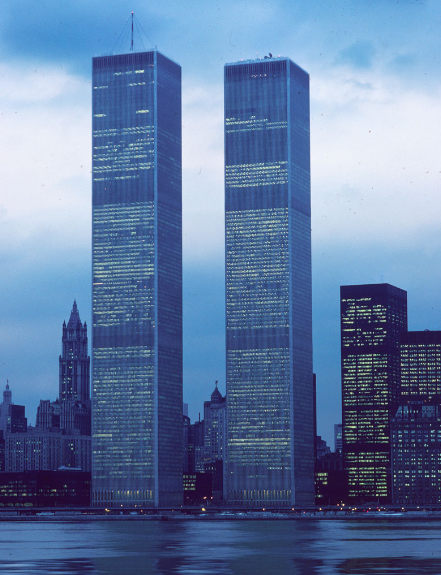
- Architectural Marvel:
- The World Trade Center, before the September 11 attacks, was not just a symbol of New York City’s financial prowess but also an embodiment of architectural innovation and modern design. Its conception and construction showcased the ambition and vision of a city constantly pushing the boundaries of what’s possible.
- Designed by architect Minoru Yamasaki in collaboration with Emery Roth & Sons, the World Trade Center complex was a testament to the advancements in skyscraper design and engineering. The Twin Towers, standing at 1,368 and 1,362 feet respectively, were the tallest buildings in the world when they were completed in the early 1970s.
- One of the unique features of the towers was the “tube-frame” structural design, which allowed for open floor plans without the need for interior columns. This design not only maximized office space but also provided flexibility in interior layouts. The facade, with its closely spaced vertical columns, gave the towers their distinctive grid-like appearance, while also contributing to the building’s structural integrity.
- Beyond the Twin Towers, the World Trade Center complex included several other buildings, each with its architectural significance. The plaza, with its iconic spherical sculpture “The Sphere,” was a gathering place for New Yorkers and visitors alike, offering a respite from the hustle and bustle of the city.
- The September 11 attacks tragically brought down these architectural marvels. However, their legacy lives on. The new World Trade Center complex, with the One World Trade Center as its centerpiece, carries forward the spirit of innovation and architectural excellence. Designed with modern safety standards and sustainable practices, the new structures pay homage to the original towers while symbolizing hope, resilience, and the indomitable spirit of New York City.
- The Twin Towers in Popular Culture:
- Before the September 11 attacks, the World Trade Center’s Twin Towers were not only iconic landmarks but also prominent fixtures in popular culture. Their towering presence was emblematic of New York City, and they found their way into numerous films, television shows, music videos, and literature, symbolizing the city’s energy, ambition, and resilience.
- Film and Television: The Twin Towers graced the silver screen in countless movies. From being the backdrop in romantic scenes to action-packed sequences, they were a go-to location for filmmakers. Movies like “King Kong” (1976) featured the giant ape climbing one of the towers, while “Home Alone 2: Lost in New York” showcased the towers as part of the city’s skyline that young Kevin McCallister explored. In television, the towers often appeared in establishing shots of New York City in series like “Friends” and “Seinfeld.”
- Music and Art: Many artists and musicians have been inspired by the Twin Towers. Album covers, such as Supertramp’s “Breakfast in America,” featured the towers. They also appeared in numerous music videos, symbolizing the city’s vibrant music scene and cultural dynamism.
- Literature: Authors often used the World Trade Center as a setting or reference point in their narratives. The towers, with their imposing stature, served as metaphors for the highs and lows of characters’ lives, the challenges they faced, and the aspirations they held.
- Merchandise and Memorabilia: From postcards and T-shirts to snow globes and posters, the Twin Towers were a favorite among tourists and locals alike. They represented New York City for many, and souvenirs featuring the towers were sought after by visitors from around the world.
- The September 11 attacks added a layer of poignancy to these cultural references. Today, when one sees the Twin Towers in old movies or TV shows, it’s a bittersweet reminder of a different time. However, their legacy in popular culture ensures that they continue to live on in the collective memory, symbolizing the spirit and essence of New York City.
- The Rebuilding: One World Trade Center:
- In the aftermath of the September 11 attacks, the gaping void left by the fallen Twin Towers became a solemn reminder of the tragedy. However, New York City, known for its resilience and spirit, embarked on an ambitious journey to rebuild and reclaim its skyline. At the heart of this endeavor was the construction of the One World Trade Center.
- Design and Vision: The design for One World Trade Center was the result of an international design competition. The winning design, by architect David Childs, envisioned a soaring skyscraper that would be both a tribute to the original towers and a symbol of hope and renewal. With its spire, the building reaches a symbolic height of 1,776 feet, a nod to the year of America’s independence.
- Innovative Architecture: One World Trade Center is a marvel of modern architecture and engineering. Its base is fortified, designed to withstand potential threats. The tower tapers as it rises, with its sides forming eight isosceles triangles. The building’s facade, made of shimmering glass, reflects the sky, changing hues with the time of day and weather.
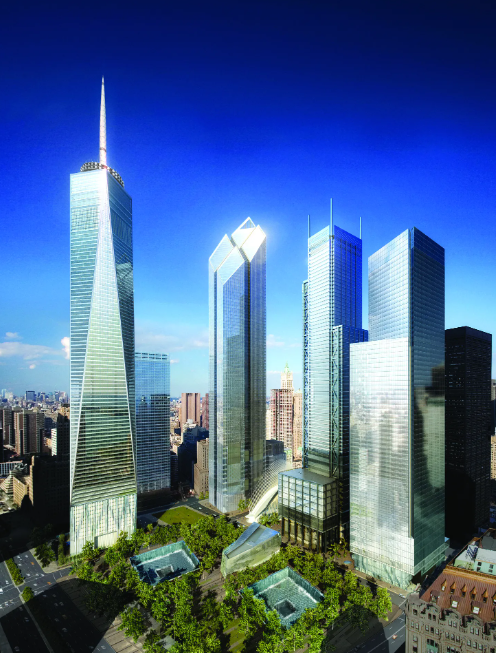
- Safety and Sustainability: Lessons from the September 11 attacks were incorporated into the building’s design. One World Trade Center boasts a robust core, enhanced fireproofing, and advanced evacuation systems. Additionally, the building is a model of sustainability, with features like rainwater harvesting, energy-efficient systems, and use of recycled materials.
- Observatory and Amenities: The One World Observatory, located on the top floors, offers breathtaking views of New York City and beyond. Visitors can see landmarks, rivers, and the expansive skyline from a vantage point like no other. The building also houses state-of-the-art office spaces, restaurants, and retail outlets. [cnn.com]
- A Symbol of Resilience: More than just a skyscraper, One World Trade Center stands as a testament to the indomitable spirit of New York City and its people. It symbolizes rebirth, resilience, and the city’s unwavering commitment to moving forward, even in the face of adversity. (USnewsSphere.com)
- In conclusion, One World Trade Center is not just an architectural marvel but also a beacon of hope, signifying the city’s ability to rise from the ashes and look towards a brighter future.


